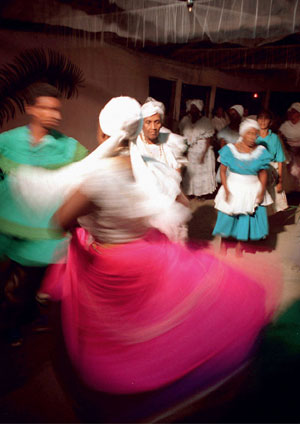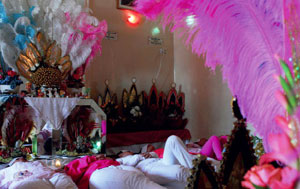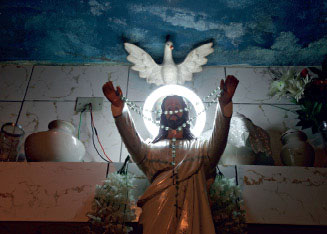
ALBANI RAMOS / FOLHAPRESSChildren of saint receive entities during the religious ceremony at the terreiro of Pai Benedito, in Codó, MaranhãoALBANI RAMOS / FOLHAPRESS
According to the Map of religions, recently published by the Getúlio Vargas Foundation (FGV), the number of people who declared themselves to be umbandistas represents 0.23% of Brazil’s population. In 1980 it was already a waning 0.6%, declined to 0.5% in 1991 and to 0.3% in 2000, according to the IBGE. What are the consequences of this demographic shock to umbanda, which is claimed to be the first effectively Brazilian religion? “That Catholicism was going to decline increasingly was expected. But umbanda, the ‘Brazilian religion’ by antonomasia, a mixture of Indian, black and European, a consummate prosopopoeia of our constitutive miscegenation that social scientists considered as a fully adjusted religious form, given that it syncretizes the Brazilian reality, even the most urban and modernized, is a phenomenon that gives pause for thought. I’m amazed at the decline in umbanda, the ‘Brazilian Brazil’ going down the drain,” is the analysis of Flávio Pierucci, a sociologist at the University of São Paulo (USP) and author of A religião como solvente (2006) [Religion as a solvent]. In the final pages of As religiões africanas no Brasil (1958) [African religions in Brazil], Roger Bastide was already warning of the “threats that are hovering over umbanda,” without which there is no longer any safe defense against the tensions and conflicts that are peculiar to a society of classes. Umbandista communities would no longer be “niches.” In them the values of a corrupted sacredness would merely reflect the dilacerations of the inclusive society.
Not everything that is magic dissolves in the air: what are we losing with the weakening of umbanda?
“Brazilian cultural history can be learned and grasped not only in history books but also in the terreiros [yards/areas where umbanda rituals take place] of umbanda. Umbanda reinterprets the values, historical views and national happenings, by conversing with reality. The classes to which their spirits belong also reflect groups that generally suffer or suffered from social exclusion, a mark of resistance and preservation of a way of conversing with the social reality in a particular way as to articulate social inclusion through its rituals,” says psychologist José Francisco Miguel Henriques Bairrão, a lecturer in social psychology at USP, where he coordinates the Laboratory of Ethnopsychology, which studies phenomena linked to umbanda, like the umbandista trance, an enunciative act in which personal and social reminiscences are condensed. “Unconscious ancestral spokespeople, these memories, once recalled, can distribute psychic and symbolic benefits to their heirs,” recalls the researcher. According to Bairrão, the umbandista pantheon comprises personalities that signal a need in the past (collective memory), and in many cases in the present too, of attention and inclusion, a view that is very far from the “theology of prosperity” of the Universal Church, which sees in it a rival to be decimated as the religion of the devil and of evil.
The religious peculiarity of umbanda, says the author, which is neither African nor Christian, may be its expression of a striking cultural heritage that is worthy of the Brazilian social reality. It contains processes of social inclusion and can be a way of preparing significant Brazilian social groups for traumatic social experiences. For Bairrão, the study of the popular religious imaginary of umbanda, in addition to allowing details to be obtained for finding out about the Brazilian social and psychic reality, can also help in the development of ethical strategies for working with communities and the consolidation of an empirical method for studying alterity, as he analyses in his research Imagens e signos no corpo da umbanda, [Images and signs in the body of umbanda], funded by FAPESP. For the researcher, umbanda is also an excellent opportunity to reflect on social and alternative forms of ethnic and cultural resistance.
“It offers an unequalled occasion for learning with the popular sectors and comparing and contrasting psychologism and individualism, consecrates the human, by placing in its pantheon the totality of its subtleties, whether agreeable or not, a witness to a singular ethic, of a universal vocation that proposes a sense of psychological and social inclusion that is politically indocile to historic and theoretical attempts at manipulation,” he assesses. For all these characteristics umbanda is a place par excellence for housing the dispossessed minorities, especially the blacks, even though, as Pierucci observes, “affirmatively African and remarkably popular, it did not restrict itself ethnically to its “blackness” but offered itself in a Brazilian way to all Brazilians.” The numbers prove otherwise: the blacks who converted to Pentecostalism proved to be proportionally much greater (14.2%) than those who say they are followers of the religion of the orixás (3%). The 2000 Census revealed that in Brazil there were around 2 million black evangelicals, compared with fewer than 100,000 blacks who said they followed Afro-Brazilian cults (66,398 in umbanda and 29,123 in candomblé). Studying umbanda and understanding these mechanisms has therefore become necessary. “The apparently unstoppable growth in conversions to Pentecostal and neo-Pentecostal churches with their Protestant roots shows that in Brazil today experiencing a religion implies breaking with the religious past. In these breaks with the religious world that before seemed to be enough, but suddenly no longer is, there are many farewells. Among them is a farewell to the umbandista syncretism that supposedly adheres with homologous perfection to Brazilian cultural identity,” is Pierucci’s assessment. “This demonization of the orixás functions because people are afraid, with pastors systematically appearing on television or on the radio saying that this is of the devil, people really begin to find that there are devil religions in Brazil.”

LEO RAMOSMeditation during the magnetizing ceremonies in a terreiro in Rio. Alongside, an offering in exchange for knowledge: advice from entities is valuedLEO RAMOS
From its zenith umbanda fell in just a few years. For followers of the religion the first manifestation of umbanda without links to Kardecism or with candomblé occurred in São Gonçalo, in Rio, on November 15, 1908. On this day in the Tenda Nossa Senhora da Piedade, medium Zélio Fernandino de Moraes, then 17 years old, received Caboclo Sete Encruzilhadas. The religion was founded, as was the first umbanda terreiro, both of which were officially recognized from then on. A recent religion, it developed in the 1920’s, when Kardecists from the middle class, attracted by the spirits of caboclos and “old blacks,” who were associated with the Rio macumba terreiros, took over the leadership. They immediately excluded the more “primitive” rituals that upset the sensibilities of the middle classes from the religious services, moralized the “guides,” by educating them in the principles of Christian charity in a Kardecist interpretation, rationalized beliefs and organized the first federations that associated terreiros that until then had been fragmented.
In the 1930’s and 1940’s it began to spread through the most modern of urban fabrics in the country, that of the large cities in the most developed region, the southeast. The prospect of constructing a national identity had always been present with the intellectuals, at least since the Republic, which immediately favored goodwill with umbanda. In 1941 they held the First National Umbanda Congress to eliminate once and for all the stigma of “macumba.” In the 1960’s, their efforts were rewarded and the religion was officially recognized in the national census. Umbanda festivals began to be included in the official calendars and in the 1970’s it was the fastest-growing faith, with an estimated population of 20 million faithful. The decline set in the 1980’s in line with growth in the Pentecostal sects and has never stopped. The latter have developed in the wake of the metropolitan crisis of the last few decades, occupying the space of the terreiros on the outskirts. “With the increase in poverty people either become involved in religions whose practices are more intense, like the Pentecostals, or lose hope and give up religion,” explains anthropologist, Ronaldo de Almeida, a researcher at the Brazilian Center of Analysis and Planning (Cebrap).
The “theology of prosperity” in the Universal Church turned the poor into economic players and made them responsible for their own salvation. Umbanda, in its turn, works with more socially “engaged” registers. “Justice, seen from the viewpoint of the subordinates and the dispossessed, who are marginalized or precariously disposed in social places, appears as a moral basis of the magic umbanda practice,” observes sociologist, Lísias Nogueira Negrão, author de Umbanda: entre a cruz e a encruzilhada (1998) [Umbanda: between the cross and the crossroad].
According to the researcher, this private morality, which legitimizes the punishment of evil by its victims, is far from the current bourgeois morality. “Rather, it is a morality based on the feeling of justice of those who live in a competitive environment, without the means they need to face up to their daily struggle and overcome their problems. This is pragmatic ethics, which does not oppose abstract values to restrictive concrete relationships, but recognizes them and accepts them as they are: requirements and demands. “A way of seeing the world that arms its “rivals,” putting at risk the religion because of its “demonization.”
Undoubtedly, notes Bairrão, in their commitment to disguise strategies vis-à-vis the dominant, the Exus and Pombagiras are associated with the darkness not only in a metaphysical way, but above all in social and political facets. The Exus perform the function of giving citizenship to the repressed, of symbolizing it mythically from the psychological and social viewpoint. Therefore, if the reign of the “left” in umbanda (of “spirits without light”) guards the hidden, it is equally docile to any attempts at domination. For the researcher, umbanda, in making its followers deal with more obscure sides, reinforces their libertarian strength to teach the functioning of the less demonstrable social and collective aspects and, because of this, truer aspects. “The umbandista ‘left’ is the metaphysical evil, but one that is personal and socially ‘spoken badly of’: sensuality, revolt, biting criticism, inappropriate words, a lack of hypocrisy and pleasure without gags. It is the guardian of something precious: freedom, incarnating a social sense of resistance and vitality,” he explains. In this context the Exus are not evil, although they may be (badly) seen as such, the response to evil as expropriation of itself in favor of something good from the other.
This incentive to “action” is in the daily life of the followers, even in their love relationships, as revealed by the research of anthropologist Kelly Hayes from the University of Indiana, who has just launched in the USA Holy harlots: femininity, sexuality, and black magic in Brazil (University of California Press), a study on Pombagiras. “They are the embodiment of transgressing femininity, which is both desirable and deadly, the ‘black side’ of woman. Perhaps in no other place in Brazil has this figure been imbued with the power to take revenge and to take charge,” says Kelly. According to the anthropologist, the entity is venerated by the working classes in the urban centers, in particular by women and homosexuals. “Those who receive the Pombagira in possession of a trance, whether men or women, are transformed for a time into super-female, seductive queens and foul-mouthed prostitutes under the ‘disguise’ of the Pombagira. Those possessed gain the power of demand over their lovers and husbands, altering events over which, without the entity, they would have little or no control,” she says.

JOSÉ PATRÍCIO/ AGENCIA ESTADOSculpture with a rosary in the ceremonial of the Caboclo Sete FlechasJOSÉ PATRÍCIO/ AGENCIA ESTADO
“It is believed that the Pombagira has a very rich experience of life and her advice is valued for its understanding of desires and fantasies,” analyzes sociologist, Reginaldo Prandi, author of Pombagira e as faces inconfessas do Brasil (1996) [Pombagira and the unconfessed faces of Brazil]. “She opens up access to instincts and unconfessed desires and her cult reveals the ‘least noble’ side of the popular conception of world, a negation of the stereotype of the cordial Brazilian. With the Pombagira it’s war.” This is not, however, a ‘thing of the devil’. “Umbanda recognizes evil as part of human nature and decharacterizes it with evil, because it is a religion of liberation and not of putting an end to human passions, like the Pentecostals,” he analyzes. Because of this the researcher believes that the feminine Exu adapted very well to Brazil. “Brazilian women suffer from the pressure of being at the same time both sexually attractive and chaste. Many women internalize this conflict and suffer because they do not know how to deal with it,” says Kelly. According to the American, this dilemma leads both to the national obsession with plastic surgery and to devotion to the Pombagira by the people. “For those who cannot pay an analyst the Pombagira allows them to live with impulses and desires that are not socially acceptable in their environment.”
Therefore, the trance gives the housewife ‘permission’ to do unthinkable things in her daily life, in addition to giving her the strength to challenge unfaithful and violent husbands. It is the Pombagira who exacts revenge. “For women Umbanda legitimizes a world that breaks away from the dominant rules and gives a moral language and a ritual repertoire that facilitates her when it comes to articulating these alternative meanings,” says Kelly. A “triangle” is formed between the woman, Pombagira and the husband, who surrenders in the face of the wife’s new strength, thus redefining relationships. “This allows women to negotiate patriarchal conventions of gender and sexuality that relegate them to a subordinate place to the man, limiting feminine power to the domestic sphere and stigmatizing the sexuality of the woman, while the man is allowed to do everything.” The figure of the Pombagira had an effect on the minds of men, even the intellectuals. “It was ethnologist, Ruth Landes in 1940, who first indicated the presence of transgressing gender relations in the possession ceremonies, with the formation of the ‘matriarchized’ men and a greater exhibition of male homosexuals in the terreiros,” says the anthropologist from Unicamp, Patricia Birman, author of Transas e transes: sexo e gênero nos cultos afro-brasileiros (2005) [Sexual relations and trances: sex in Afro-Brazilian cults]. Until then, saint houses were carefully preserved by researchers like Bastide and Arthur Ramos and seen as a social and moral harmony that needed to be defended, a politically correct view that was intended to reject the stigma of these communities that should be elevated to such a level that would not frighten away the “whites” and their families.
“The moral horizon oriented the academics to value the reproductive face of feminine identities and to exclude any deviating aspects. The ideal of motherhood and the adjustment of gender relations made the women of these terreiros somewhat asexual, subordinated to family life and the patriarchal hierarchy,” notes Patricia. Powerful women and male and female homosexuals constructed families of the saint that their defenders, intellectuals from the Brazilian elite, looked at separately with frankness and romanticism, diligently erasing the very obvious marks (largely bodily) in which sex, gender and power were so easily brought together.” This analytical picture was only modified as from 1968. But in the meanwhile Pombagiras continued to affect the female imagination. “They changed power relations into devoted and sexual relationships. After all, invisibility gives protection and power to the ‘horse’, whose man does not have the same spiritual mediations. He surrenders and sees himself obliged to submit to a pact with the invisible being,” analyzes the anthropologist, Stefania Capone, author of A busca da África no candomblé: tradição e poder no Brasil (Pallas) [The search for Africa in candomble: tradition and power in Brazil]. The “active” mark of umbanda is reiterated, and at the same time its most fragile facet when faced with attacks.
“In Brazil today one of the most outstanding aspects of the ‘social force’ that still has a certain type of religion is precisely its statistically proven capacity to dissipate former attributes and ruin the established religious lineage; a bye-bye, Brazil!,” analyzes Pierucci. A religion, he affirms, that is destructive and predatory and that from individual salvation, just grows by extracting members from other groups, which once individualized, are engaged in the creation of a community that merely offers religious ties. “Do you want a universal cultural solvent” Pick a congregational type religion, is Weber’s recipe. ‘Pick and pay’, should be added to our neo-Pentecostals.”
The project
Images and signs in the body of umbanda – no. 2007/04368-1
Modality
Regular Line of Research Project Awards
Coordinator
José Francisco Bairrão – USP
investment
R$ 55,670.00 (Fapesp)
